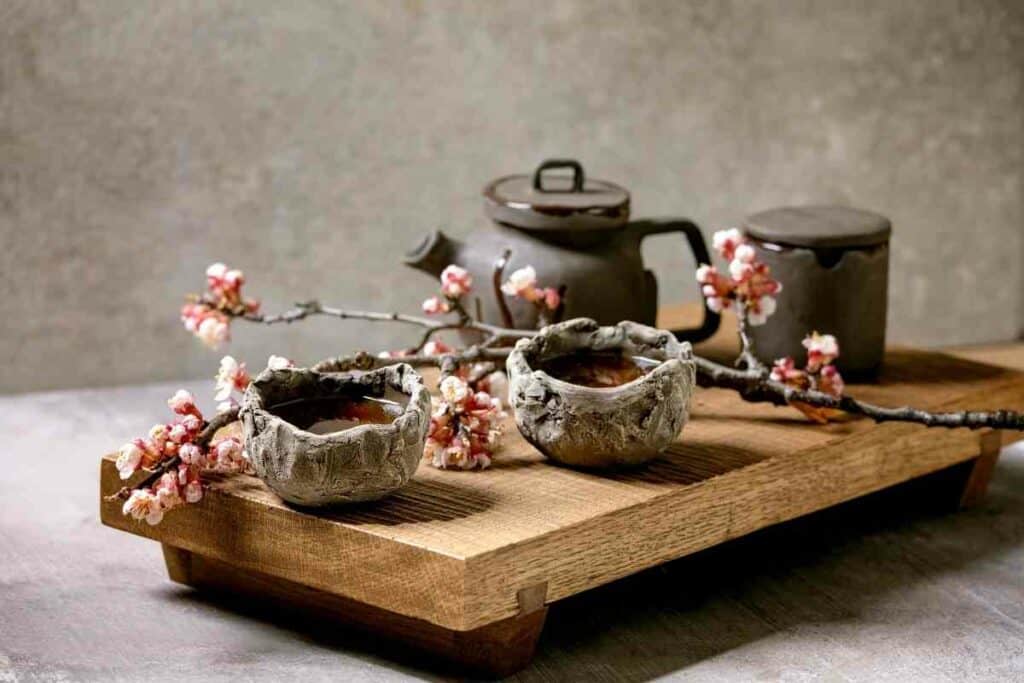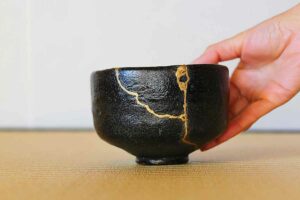Do you constantly find yourself under pressure to conform to the latest trends?
Are you feeling that your life is getting out of control? Are you spending money on impulse purchases, only to regret it later?

Well, you aren’t alone. Social media increases the fear of missing out; as a result, you find yourself buying unnecessary items or feeling that you’re behind your peers.
This is where the Wabi-Sabi comes in handy – it teaches you to be content with your possessions instead of constantly yearning for more.
Table of Contents
What is Wabi-Sabi?
Wabi-Sabi combines two words, wabishisa and sabishisa, which loosely translate to the beauty of imperfection in English.
It’s an ancient Japanese philosophy that teaches people to accept the flaws of life.
Wabi-Sabi borrows a lot from Buddhism in that it appreciates life’s transiency.
The philosophy gained popularity in tea ceremonies where people used imperfect, handmade utensils.
The Relevance of Wabi-Sabi
There’s no denying that many people desire perfection, although it’s almost unattainable.
For instance, the Chinese concept of Feng Shui and Marie London’s KonMari method have a substantial following worldwide; both celebrate balance, organization, and symmetry.
But, on the contrary, Wabi Sabi encourages you to abandon idealism and find beauty in imperfections.

Wabi-Sabi is priceless – you can’t put any value to it.
Yet, you can find it in the most unlikely places; cracked chinaware, exposed bricks on your walls, frayed sleeves on your best sweater, broken door handles, restored cars, etc.
You won’t find Wabi-Sabi in high-end smartphones, uptown skyscrapers, luxury cars, symmetrical flowerbeds, etc.
Wabi-Sabi is the antithesis of the widespread belief that beauty lies in perfection and symmetry.
Authenticity and simplicity are integral to Wabi-Sabi. Its practitioners cherish the cracks and defects that others would find undesirable.
Keep In Mind – Embracing this concept teaches you to be content with your possessions without always desiring more. It’s the ideal solution to the many unrealistic desires of modern society.
How Do You Find Beauty in Imperfections?
Society raises children to strive for the best, always going for number one.
In school, only the top get rewards.
Outside, you need to do something extraordinary to earn societal recognition.
It seems unnatural to seek pleasure in mundane tasks, let alone a concept that adores imperfections.
So, how do you abandon these ingrained norms and start practicing Wabi-Sabi?
Accepting the world as it is (imperfect and unfinished) and celebrating the reality seems daunting, but it isn’t.
In truth, it’s tempting; the idea of deviating from societal norms is pretty cool.
The Seven Principles of Wabi-Sabi

You must adopt the following seven principles to achieve a Wabi-Sabi lifestyle.
Kanso: Simplicity
The Kanso principle focuses on clarity and encourages decluttering.
Like minimalism, it teaches the less is more approach to life.
Kanso encourages you to be more selective with your use and worry less about what you don’t have. It also motivates you to devote more time to what matters most.
Fukinsei: Asymmetry
Most people’s perception of beauty lies in symmetry.
However, it can be pretty challenging to achieve balance. You might stress yourself trying to achieve the unattainable.
Fukinsei challenges your perception of beauty. It describes asymmetry as beautiful and natural, which is why everything in the world is amazing. Everything, including the imperfect, is adorable.
Shibumi: Beauty in the Understated
Shibumi encourages you to focus on the elegance of simplicity over showiness. It’s quite similar to Kanso, focusing on minimalism and authenticity.
Shizen: Naturalness
In the western world, naturalness defines untouched and wild things.
The Japanese have a different definition – human beings are an integral part of nature.
So, for instance, the Japanese create gardens to be in harmony with nature.
Yugen: Subtle Grace
Yugen finds beauty in concealed items.
The objective is to create a feeling of mystery and leave your mind thinking of many possibilities.
Yugen is particularly useful to artists, designers, and photographers since revealing less leaves the audience in suspense, thinking about what the piece implies.
Datsuzoku: Freedom from Habit
One of the hallmarks of perfectionism is adhering to a strict routine.
On the other hand, Datsuzoku encourages you to explore the unconventional and embrace the unknown.
When you break your routine habit, you open a world of possibilities. Spontaneous activities are exciting and foster creativity.
Seijaku: Tranquillity
The last principle, Seijaku, promotes tranquillity and solitude.
Its objective is to encourage you to practice mindfulness and meditation to help you deal with the ups and downs of life.
When you live by Seijaku, you’ll find peace and calm in an otherwise chaotic society.
How to Apply Wabi-Sabi in Real-life Situations

Here are some ways of applying the principles of Wabi-Sabi in your life.
Home
Start by assessing your possessions before adding new items to your home.
Then, get rid of clutter and remain with the most important things.
Removing unnecessary items from you brings clarity to your life. It also strengthens your freedom from attachments to life’s materialism.
Ultimately – It relieves anxiety and stress, giving way to peace and calm.
Take things away before adding new items to your home. This way, you’ll have enough room for the essentials you desire.
Remember, less is more. Moreover, emptying the space around an item transforms into the room’s focal point.
Regarding colors, earthy neutrals work best for Wabi Sabi interiors.
This is because they perfectly match the walls of old Japanese homes made from mud.
Alternatively, you can leave your walls bare, making them rustic over time.
For instance, exposed brick or peeled-off paint exudes a feeling of the Wabi Sabi lifestyle.
Food
Wabi-Sabi principles encourage you to use intuition to prepare natural and simple meals.
Instead of aiming to match top-rated chefs, have fun and confidence in your cooking skills.
If you don’t have a particular ingredient, improvise. The arrangement doesn’t have to be meticulous – you can splatter the foods all over the plate, provided it’s savory and nutritious.

Use utensils with heft and texture for a sensory eating experience.
When Eating – Don’t focus on the tastes alone. Instead, inhale the rich aroma, listen to the sounds, and feel the textures in your mouth.
The Wabi-Sabi concept trains you to appreciate the little things and use them to engage your senses.
Fruits and vegetables from the local farmers’ market or your backyard garden are quintessential Wabi-Sabi. They are simple, asymmetrical, and natural.
Work
It seems impractical to apply the Wabi-Sabi philosophy in the workplace.
After all, no employer wants a laid-back approach that compromises productivity.
However, Wabi-Sabi at work is about being valued for your worth and unique qualities.
Ensure that your words and actions match your values. This is the perfect way to reflect on your true self.
Authenticity helps to eliminate power struggles in the office, making your work life free of troubles.
Embracing Wabi-Sabi at the workplace starts with identifying and focusing on your distinctive qualities.
For Instance – If you prefer solace, you might find it challenging to mingle with colleagues who are natural collaborators.
However, differences between you and your workmates shouldn’t hinder your productivity.
If you feel distracted, remember the transience of the job. Knowing that everyone is unique allows you to find peace and boost your productivity.
Relationships
Samurai, traditional Japanese warriors, never entered social places with their swords.
Leaving the sword outside symbolized abandoning their conflicts and pretentious nature.
You can apply this analogy to your relationships if you want to embrace the Wabi Sabi concept.
Simply put, a Wabi-Sabi relationship requires you to accept your partner as imperfect, mortal, and unfinished.

While perfection is desirable, most people know that it’s unattainable.
Furthermore, expecting a flawless partner is unreasonable – remember, you also make mistakes.
When In a Relationship – Lower your expectations. Instead, focus on the strengths of your partner. Accepting your partner’s flaws, instead of considering them a project that needs fixing, saves you the disappointment of learning that nothing is perfect.
Benefits of Embracing the Wabi-Sabi Lifestyle
Embracing the Wabi Sabi lifestyle teaches you to appreciate yourself.
When you love your imperfect home, it’s easier to resist the urge to buy new things. This saves you money, enabling you to focus on significant projects.
Additionally, Wabi-Sabi changes your mindset. Instead of always yearning for flashy items, you love what you already own.
This change in perspective makes you content, resulting in increased serenity and tranquility in your life.
Lastly, the Wabi-Sabi philosophy is helpful in many aspects of life.
For example, at the workplace, it trains you to overlook the flaws of others and focus on their strengths.
In relationships, it encourages you to accept your spouse as they are instead of looking to fix them.
Wrapping Up
If 2020 was anything to by, life is full of surprises and will always be imperfect.
The best way to shield yourself against the negativities resulting from unprecedented changes is to adopt the Wabi Sabi lifestyle.
Once you acknowledge that the world is imperfect and transient, you’ll lead a happier life.
Also Read
- Japanese Wedding Traditions (Venue, Dress & Food)
- Kintsugi: Perfectly Imperfect Ceramic Art (with 8 Examples)
- 5 Best Japanese Makeup Brushes for a Flawless Finish
- Maiko Vs Geisha Compared: What Are the Differences?
- Japanese String Instruments (9 Famous Ones)
- Best Onsen Destinations In Japan (10 Top Locations)










